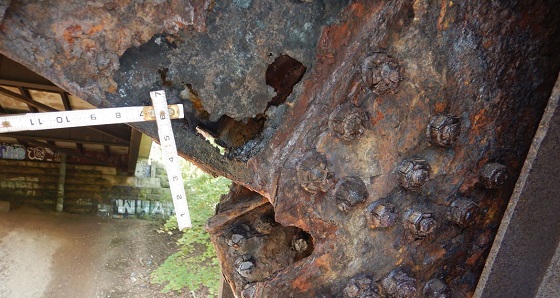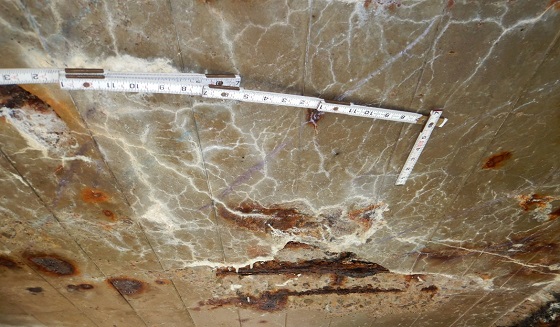After a right-to-know records request from the Pittsburgh Post-Gazette, the Pennsylvania Department of Transportation (PennDOT) (Harrisburg, Pennsylvania, USA) released an inspection report completed on the Fern Hollow Bridge prior to its January 2022 collapse.
That 100-plus-page report,1 which was based on an inspection that took place in September and October 2021, pointed to major structural decay. “The overall physical condition is poor, as indicated by the condition ratings,” the report concludes.
Despite these findings, no immediate repairs were ordered. The 447-ft (136.2 m) rigid steel frame bridge subsequently collapsed on the morning of January 28, 2022, injuring several people.
Cross Bracing Deteriorates
The report from investigators at engineering company Gannett Fleming (Camp Hill, Pennsylvania, USA) is redacted in parts, but it identifies areas of exposed rebar, as well as corrosion and holes in support beams and decay in the deck. This allowed water to seep through.
“The cross bracing is deteriorating due to malfunctioning drainage systems in addition to deterioration, contamination, and seepage through the deck concrete,” the report says of the three-span bridge, which was built in 1970 and owned by the City of Pittsburgh. “Areas of heavy corrosion appear below deck weepholes, with several missing or loose connection bolts.”
In the report to PennDOT, inspectors detailed how the cross-beams had deteriorated for more than a decade, owing to “severe corrosion and holes in webs at bracing connections.” According to investigators, legs and crossbeams underneath the bridge’s west end were badly decayed and had gaping holes. In 2019, the lower cross-bracing between some of the west-end legs was removed because it had deteriorated to an extent that it was hanging detached from the bridge.

Other Inspection Findings
In 2009, the city began installing wire tensioning cable to assist with lateral support. While the cables were retightened in 2014 and found to be in good condition and tight, it remains unclear whether these cables offered sufficient support.
The inspection notes that the bridge’s four steel legs had showed significant deterioration. “The frame legs are in poor condition,” the report reads. “The frame legs exhibit laminar rust and holes in the webs. There are five stiffeners at each bent leg that exhibit 100-percent section loss.” These stiffeners had been placed up and down the legs as a means of additional support to the main beams.
Furthermore, up to a 50-percent section loss was visible on bolts to the inside of a girder splice plate, which connected the bridge’s west end to the central portion. The splice plate joins the horizontal spans of the bridge together with bolts, rather than welds.
Inspectors noted spalling beneath the concrete bridge deck, with water seeping from the top of the deck through to the steel. This was likely caused by chloride-laden liquids from melting snow each winter. “Spalls with exposed rebar and delaminations are scattered throughout the deck,” the report reads.

Previous Recommendations and a Path Forward
Despite finding these various issues, inspectors in late 2021 did not call for reducing the 26-ton weight limit that had been in place in recent years. “Because the condition of the main load carrying members has not changed significantly, the 2014 Load Rating Analysis is still valid,” the report reads. At the time of the January 28 collapse, an articulated Port Authority bus and four passenger vehicles were reportedly on the bridge. Afterward, a fifth passenger vehicle drove off the east bridge abutment.
As part of the inspection report, series of “Priority Code 2” and “Priority Code 3” short-term improvement recommendations were issued to PennDOT, with the most expensive being “upgrade bridge rail to current PennDOT standards” for $178,800. A similarly expensive recommendation was “repair spalled and delaminated concrete underside” for $160,000.
All “short-term improvements” recommendations were called for within two years. There were no listings, however, in the immediate improvements section, which would have required prompt action.
According to PennDOT, the limited redactions within the report were made due to security reasons. “Certain information, if made publicly available, would show fracture critical information…and otherwise show information about ways in which bridges could be intentionally damaged,” says Alexis Campbell, PennDOT’s chief spokeswoman, in a statement to the Pittsburgh Post-Gazette.2
The bridge is now in the process of being rebuilt, which could take years. The National Transportation Safety Board (NTSB) (Washington, DC, USA) is conducting its own investigation into the collapse, though NTSB officials said in February 2022 that it could take from 12 to 18 months to issue a final report.
Based on that active investigation, Gannett Fleming did not issue any further comment.
Sources: PennDOT, www.penndot.gov; NTSB, www.ntsb.gov; Gannett Fleming, www.gannettfleming.com.
References
1 “2021 Routine Bridge Safety Inspection Report: City of Pittsburgh, Allegheny County, Forbes Avenue over Fern Hollow and Nine Mile Run,” City of Pittsburgh and Pennsylvania Department of Transportation Engineering District 11-0, https://www.scribd.com/document/575091953/2021-Fern-Hollow-Bridge-Inspection (June 16, 2022).
2 S.D. Hamill, “Fern Hollow Bridge Was Severely Decaying Before Collapse, 2021 Report Indicates,” Pittsburgh Post-Gazette, May 23, 2022, https://www.post-gazette.com/local/city/2022/05/19/fern-hollow-bridge-inspection-2021-report-severely-decaying-rust-corrosion-penndot/stories/202205190154 (June 16, 2022).